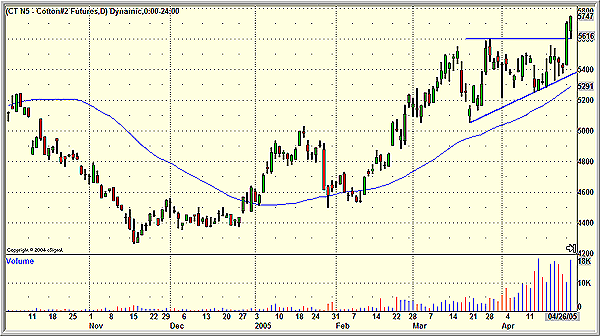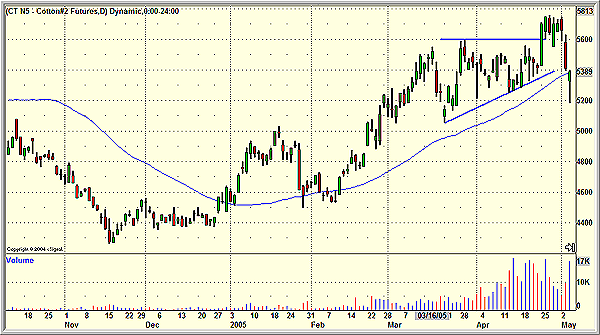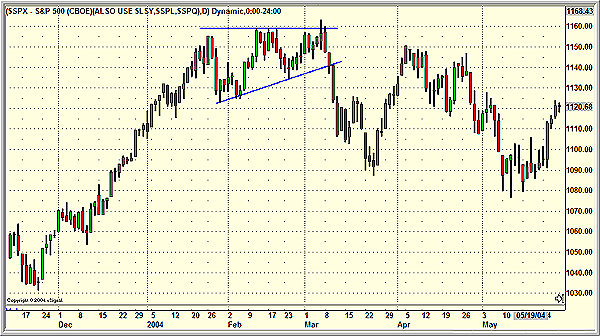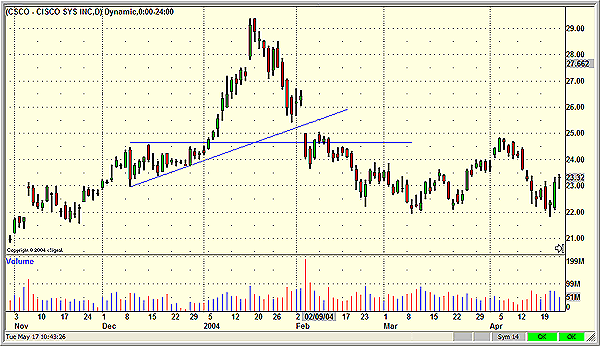
HOT TOPICS LIST
- MACD
- Fibonacci
- RSI
- Gann
- ADXR
- Stochastics
- Volume
- Triangles
- Futures
- Cycles
- Volatility
- ZIGZAG
- MESA
- Retracement
- Aroon
INDICATORS LIST
LIST OF TOPICS
PRINT THIS ARTICLE
by Paolo Pezzutti
Bullish triangles forecast a volatility expansion--but not always on the upside.
Position: N/A
Paolo Pezzutti
Author of the book "Trading the US Markets - A Comprehensive Guide to US Markets for International Traders and Investors" - Harriman House (July 2008)
PRINT THIS ARTICLE
ASCENDING TRIANGLES
Bullish Triangles: Trading Scenarios
05/17/05 11:21:02 AMby Paolo Pezzutti
Bullish triangles forecast a volatility expansion--but not always on the upside.
Position: N/A
| Markets spend longer periods of time developing congestions and trading ranges than they do trends. Triangles are a form of congestion. At the beginning of their formation, you will see high volatility. As they develop, volume dries up and volatility reduces. It is not easy to spot a triangle formation early. In case of bullish triangles, they can be easily confused with double tops, rectangles, and so on. The common understanding about triangles is that ascending triangles form the most bullish patterns, while descending ones form the most bearish ones. Symmetrical triangles suggest a neutral balance although some say that they tend to continue the trend preceding the triangle formation. Ascending triangles rise toward a resistance level with buying pressure building up as prices test the upper boundary. Typically, they hit resistance three times before breaking out. A vertical thrust often develops after the congestion and prices start a new trend. They often appear as continuation patterns in a trend. False moves, however, may occur near the apex of the triangle, which is where the formation ends and is usually accompanied by low volatility. But which direction will prices move? Statistics suggest there is a bias to the upside, but in reality, you have to expect a number of different scenarios. You may have to apply different tactics, but all of them could be profitable: - Breakout to the upside and the start of an uptrend. The converse should be considered for breakouts on the downside. Statistically, it happens with a lower frequency, but the volatility can be even higher. In light of these different scenarios, you have to prepare your plan according to your personality. The most important thing is discipline and the ability to stick to your plan. Let's see some examples. |

|
| Figure 1: Cotton futures contract printing an ascending triangle from March to April 2005. |
| Graphic provided by: eSignal. |
| |
| In the daily chart of the July 2005 cotton futures contract in Figure 1, you can see the formation of an ascending triangle from March to April 2005. It was only on April 14, after the second low of the formation, that you were aware that an ascending triangle was developing. Volume distribution also suggested an upside breakout. After the apex on April 22, the breakout on the upside started with a wide range day and a followthrough on the next day. |

|
| Figure 2: False breakout. After a five-day congestion, prices went through the apex to the downside with a very fast move. |
| Graphic provided by: eSignal. |
| |
| In Figure 2, you can see what really did happen after the breakout: a false breakout. After a five-day congestion (April 26-May 2) above resistance, prices went through the apex to the downside relatively quickly. Always be prepared for something like this. After the breakout, volatility surged mainly because of stops placed above the resistance and buying by trendfollowers, but there was not enough money from the crowd to start a new trend. In Figure 3, note that the Standard & Poor's 500 index developed an ascending triangle after an uptrend between January and March 2004. Before the apex was formed, it made a breakout to the downside, with a volatility expansion that quickly moved prices to a new congestion area. |

|
| Figure 3: Emini S&P futures contract. An ascending triangle developed after an uptrend between January and March 2004. |
| Graphic provided by: eSignal. |
| |
| In Figure 4, you can see that between December 2003 and February 2004, the chart of Cisco Systems, Inc., showed a very interesting ascending triangle. After the breakout (January 5), there were 11 consecutive up days. On the subsequent correction, however, prices went back down even faster! |

|
| Figure 4: Cisco. After the breakout of January 17, there was no possibility to jump on board! |
| Graphic provided by: eSignal. |
| |
| What lessons have we learned? Although statistics say that a breakout on the upside is more likely, it brings along an increase in volatility. Given that false moves are very likely in a volatile environment, you can base your trading tactics on these false moves. Keep in mind that discipline is essential to limit your losses, especially in an environment where prices move so quickly. You can trade options during triangle formations by betting on volatility increase. You may consider entering the trade during the triangle formation in a low-volatility environment, speculating on the breakout direction, and exiting the trade on the volatility expansion. You can also wait for a pullback after the breakout, if it ever happens. Or you can capitalize on false moves by trying to fade the breakout or selling the apex fallback in the opposite direction of the breakout. Which one is right? Maybe all of them are. It depends only on how you manage the trade, your risk, and money management. |
Author of the book "Trading the US Markets - A Comprehensive Guide to US Markets for International Traders and Investors" - Harriman House (July 2008)
| Address: | VIA ROBERTO AGO 26 POSTAL CODE 00166 |
| Rome, ITALY | |
| Phone # for sales: | +393357540708 |
| E-mail address: | pezzutti.paolo@tiscali.it |
Click here for more information about our publications!
Comments
Date: 05/17/05Rank: 4Comment:
Date: 05/18/05Rank: 3Comment:

Request Information From Our Sponsors
- StockCharts.com, Inc.
- Candle Patterns
- Candlestick Charting Explained
- Intermarket Technical Analysis
- John Murphy on Chart Analysis
- John Murphy's Chart Pattern Recognition
- John Murphy's Market Message
- MurphyExplainsMarketAnalysis-Intermarket Analysis
- MurphyExplainsMarketAnalysis-Visual Analysis
- StockCharts.com
- Technical Analysis of the Financial Markets
- The Visual Investor
- VectorVest, Inc.
- Executive Premier Workshop
- One-Day Options Course
- OptionsPro
- Retirement Income Workshop
- Sure-Fire Trading Systems (VectorVest, Inc.)
- Trading as a Business Workshop
- VectorVest 7 EOD
- VectorVest 7 RealTime/IntraDay
- VectorVest AutoTester
- VectorVest Educational Services
- VectorVest OnLine
- VectorVest Options Analyzer
- VectorVest ProGraphics v6.0
- VectorVest ProTrader 7
- VectorVest RealTime Derby Tool
- VectorVest Simulator
- VectorVest Variator
- VectorVest Watchdog
